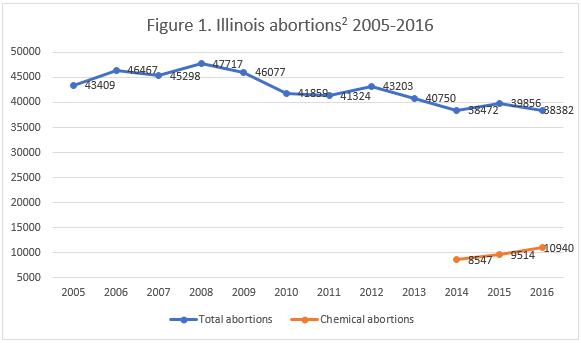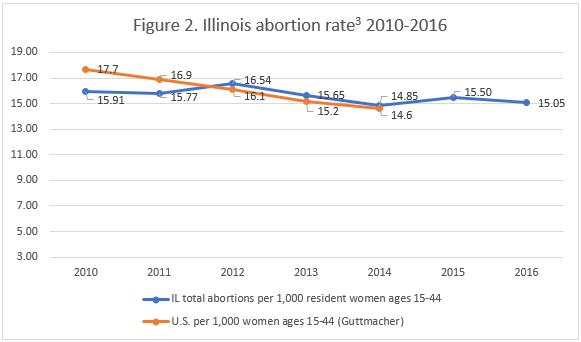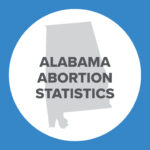Abortion Reporting: Illinois (2016)
This article was updated on January 24, 2019 with corrected abortion totals for 1995.
Illinois’ 2016 annual state abortion report was published on schedule in December 2017. The 15-page report reveals that abortion totals in Illinois are declining steadily, while chemical abortions are increasing rapidly. Illinois’ abortion report is published by the Illinois Department of Public Health.
Changes in Illinois Abortions, 2015-2016

Abortion Totals and Trends
In 2016, 38,382 abortions were performed in Illinois. This was a decline of 27 percent from 1995, the first full year after Illinois’ current abortion reporting law was enacted, when 52,300 abortions were performed. Abortions fell by 3.7 percent from the 2015 total of 39,856 abortions (Figure 1). At the same time, chemical abortions are rising. A total of 10,940 chemical abortions were performed in Illinois in 2016, making up 29 percent of total abortions. Chemical abortions increased 15 percent from 2015 and 28 percent from 2014, the first year to report chemical abortions as a separate category. Illinois does not report the state abortion rate; however, the Charlotte Lozier Institute estimates that Illinois’ abortion rate declined from the previous year (Figure 2).
State Report Summary
Eighty-five percent of abortions in Illinois were performed on state residents. Most women seeking abortions were in their twenties, with 59 percent of abortions performed on women ages 20 to 29. Ten percent were age 19 or younger and 28 percent were in their thirties. Approximately three percent were 40 or older, although the precise number was suppressed to preserve the anonymity of the women involved. Illinois suppresses data for categories in which the amount is small in order to prevent individuals from being identified (e.g., number of abortions per county of residence). The majority of women, nearly 76 percent, were unmarried, while not quite 10 percent were married. Marital status was not reported in nearly 15 percent of cases. Sixty-two percent of women had had a previous live birth. Fifty-six percent had not had a previous abortion. Though the reporting form collects information on race and level of education of the women undergoing abortions, the state report does not include this information.
Most abortions occurred early in pregnancy, with 48 percent performed between four and seven weeks of gestation. Twenty-nine percent were performed at eight to 11 weeks, nine percent at 12 to 15 weeks, and four percent at 16 to 19 weeks. At least 134 abortions were performed between 20 and 23 weeks; however, the total number of abortions at this and later gestations cannot be calculated as the data for women of unknown residence is suppressed for anonymity. All data for three weeks and earlier as well as 24 weeks and later were suppressed to preserve anonymity. Ninety-eight percent of abortions had no reported complications, although information on the total number of abortions resulting in complications, as well as which types of complications occurred, is suppressed1.
Medicaid Expansion
In 2017, Illinois expanded Medicaid coverage to pay for elective abortions with state Medicaid funds. Before the expansion, Illinois’ Medicaid program covered abortion only when the pregnancy resulted from rape or incest or when the mother’s life was at risk. The Charlotte Lozier Institute has noted the impact of Medicaid funding for abortion at both the federal and state level. CLI scholar Dr. Michael New estimates that Illinois’ Medicaid changes could increase abortions in the state by 3,800 each year. Since 1976, almost 145,000 lives have been saved in Illinois due to limitations on Medicaid coverage of abortion. Illinois could make the effect of state Medicaid funding of abortion clearer by reporting the sources of payment for abortions occurring in the state.
State Ranking
CLI’s 2016 report on state abortion reporting showed Illinois tied with Oregon as 13th best out of the 50 states, the District of Columbia, and New York City. Illinois could improve its reporting by collecting and reporting information on the forms of payment used for abortion. Though Illinois already collects data on the race and level of education of women undergoing abortions, the state could improve transparency by publishing that information in the abortion report. Additionally, Illinois could provide more data on minors who undergo abortions. The state requires parental notification before a minor can procure an abortion but does not report on this process. As Illinois anticipates an increase in the number of abortions performed in the state, accurate reporting is necessary to measure the true impact of Medicaid funding of abortion in Illinois. Illinois should also take a close look at reporting the total number of late-term abortions and the reasons given for them as the likelihood of identification of individuals is small in the experience of states to date and the public interest in the issue of elective late-term abortion is very high.


- Statistics on abortion complications reported here represent a minimal number of deaths and complications, as this data is collected in a non-systematic and non-verifiable way. As such, this data cannot be used to calculate either an accurate abortion mortality rate, nor an accurate abortion complication rate for the state.
- Chemical abortion totals were produced by summing the numbers of reported chemical abortions performed on state residents, nonresidents, and women of unknown residence. For example, in 2016, there were 9,493 chemical abortions performed on state residents, 1,131 performed on nonresidents, and 316 performed on women of unknown residence, for a total of 10,940 chemical abortions. The Illinois report labels chemical abortions as “Procedure Antiprog” (procedure antiprogestin).
- Illinois does not report the state abortion rate. Rates were calculated by the Charlotte Lozier Institute using population estimates from the United States Census Bureau. The rates were calculated using the following formula: (total number of abortions performed in Illinois ÷ number of resident women ages 15-44) x 1,000.
























